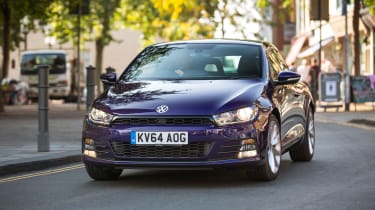Volkswagen Scirocco coupe (2008-2017) - MPG, running costs & CO2
Basic Volkswagen Scirocco coupes are cheap to run, although they’re not particularly efficient
The VW Scirocco continues to prove very popular with buyers, which means that second-hand values are high. The diesel models retain around 50% of their original price after three years and 36,000 miles. By comparison, a diesel Peugeot RCZ is worth around 45% of its original value after the same period. The Scirocco petrols retain less value than the diesels, falling into the range of 45 to 49%.
Running costs are good for the class, particularly in the less powerful models. Road tax costs £140 on models registered after 1 April 2017, and varies depending on the engine chosen on older models.
Volkswagen Scirocco MPG & CO2
Fuel economy of 52.3mpg and CO2 emissions of 125g/km mean the entry-level Scirocco is quite cheap to run for a sporty petrol-engined coupe, and attracts a £115 a year road tax bill. The next model up is the 2.0-litre TSI petrol, which can achieve fuel economy of 46.3mpg, with CO2 emissions of 139g/km for a £135 annual road tax bill. Note that the GTS model (which uses the same engine) is slightly less economical.
The Scirocco is available with choice of two diesel engines, with 148 or 182bhp. Fuel economy for the 148bhp diesel engines ranges from 67.3mpg in the manual to 61.4mpg in the automatic. The 182bhp model can return a maximum of 60.1mpg and emits 124g/km of CO2, so will cost £115 a year in road tax.
Insurance group
Insurance ratings run from group 18 for the 1.4-litre petrol to group 32 for the 2.0-litre petrol R-Line. The 148bhp 2.0-litre TDI, our pick of the engine range, falls into group 24. The performance-orientated VW Scirocco R, reviewed separately, sits in group 34.
Warranty
New Sciroccos came with a standard three-year/60,000-mile warranty with the Scirocco - exactly the same as the Peugeot RCZ, while neither BMW nor Mercedes put a mileage cap on their three-year warranties.
Servicing
Volkswagen offers a fixed-price two-year service plan, so you can spread the cost of your car’s scheduled maintenance. It offers peace of mind to anybody who frequently uses their car in stop-start urban environments on frequent short journeys where the engine doesn’t come fully up to temperature, for towing or for driving in a way that’s likely to increase wear and tear (for instance frequent rapid acceleration and heavy braking).
If that isn’t you, it’ll come as a relief that the Scirocco employs a variable servicing schedule, which uses sensors to detect when the car needs maintenance. Depending on the type of driving you do, the car will indicate that a service is due anywhere from every 10,000 miles or one year to 20,000 miles or two years. This is good news if you cover higher mileage, for example commuting daily for 25 miles or more on fast roads, whilst driving economically and carrying minimal weight.
It’s worth noting that the service plan only covers fixed-interval servicing. It covers two services over 20,000 miles.












